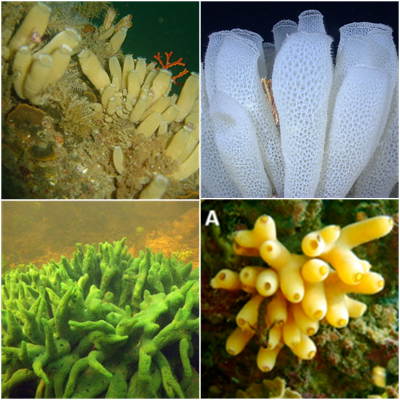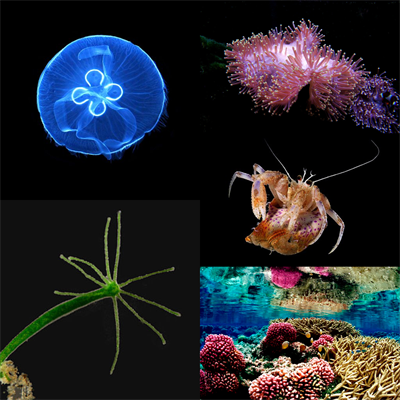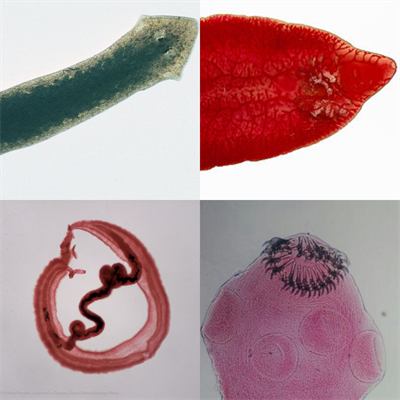
PUMPA - SMART LEARNING
எங்கள் ஆசிரியர்களுடன் 1-ஆன்-1 ஆலோசனை நேரத்தைப் பெறுங்கள். டாப்பர் ஆவதற்கு நாங்கள் பயிற்சி அளிப்போம்
Book Free DemoPhylum Porifera:
- They are commonly known as sponges.
- These are multicellular organisms that have holes or pores in their bodies.
- They are externally covered by a rigid skeleton made of spicules composed of spongin protein and calcium carbonate.
- The animals of this phylum are non-motile and attached to a solid support.
- They reproduce through asexual and sexual reproduction.

Clock-wise from top left: Leucosolenia (smallest sponge), Euplectella (Venus flower basket), Spongilla (freshwater sponge), Sycon
Phylum Coelenterata:
- They are also known as cnidarians.
- They are aquatic animals that show more body design than the poriferans.
- These are multicellular, diploblastic animals that lack organs.
- They are sessile or free-swimming, solitary or colonial (Hydra is solitary).
- They reproduce through asexual and sexual reproduction.

Clockwise from top left: Aurelia (Jellyfish), Sea anemone, Adamsia, Corals, Hydra
Phylum Platyhelminthes:
- They are commonly known as flatworms.
- These are multicellular triploblastic animals.
- They are sessile or free-swimming animals.
- They are found as either solitary or colonial.
- These are free-living parasites.
- They reproduce through asexual and sexual reproduction.

Clockwise from top left: Planaria, Fasciola hepatica (Liver fluke), Blood fluke, Taenia solium (tapeworm)
Phylum Nematoda or Aschelminthes:
- They are also known as roundworms or pinworms as they have a cylindrical body rather than the flattened one.
- These organisms have an unsegmented body.
- They are triploblastic animals.
- They are mostly parasites in human beings and animals, causing diseases such as elephantiasis and filariasis.
- They reproduce through asexual reproduction and are sexually dimorphic.

Clockwise from top left: Ascaris lumbricoides (roundworm), Wuchereria bancrofti (filarial worm), Trichuris (whipworm), Enterobius vermicularis (pinworm)
Reference:
https://upload.wikimedia.org/wikipedia/commons/8/82/Sycon_sp.png
https://upload.wikimedia.org/wikipedia/commons/thumb/6/6b/Sponges_at_SAS_Transvaal_DSC09129.JPG/512px-Sponges_at_SAS_Transvaal_DSC09129.JPG
https://www.flickr.com/photos/noaaphotolib/9734258717
https://upload.wikimedia.org/wikipedia/commons/0/0b/Spongillidae_middle.jpg
https://upload.wikimedia.org/wikipedia/commons/thumb/7/71/Pagurus_prideaux.jpg/512px-Pagurus_prideaux.jpg
https://www.flickr.com/photos/usfwspacific/5565696408
https://upload.wikimedia.org/wikipedia/commons/thumb/0/0a/Mikrofoto.de-Hydra_15.jpg/512px-Mikrofoto.de-Hydra_15.jpg
https://upload.wikimedia.org/wikipedia/commons/thumb/5/5c/Aurelia_aurita_2.jpg/512px-Aurelia_aurita_2.jpg
https://www.flickr.com/photos/volvob12b/14231557292
https://www.flickr.com/photos/carolinabio/8225394736
https://upload.wikimedia.org/wikipedia/commons/thumb/4/43/Fasciola_hepatica_%28Linnaeus%2C_1758%29_2013_000-2.jpg/512px-Fasciola_hepatica_%28Linnaeus%2C_1758%29_2013_000-2.jpg
https://www.flickr.com/photos/occbio/6414501563
https://upload.wikimedia.org/wikipedia/commons/9/9b/Taenia_solium_scolex_x400.jpg
https://www.flickr.com/photos/gtzecosan/15701719491
https://www.flickr.com/photos/occbio/6414497563
https://www.flickr.com/photos/gtzecosan/15703630875
https://upload.wikimedia.org/wikipedia/commons/thumb/e/e5/Enterobius_vermicularis-1.jpg/512px-Enterobius_vermicularis-1.jpg